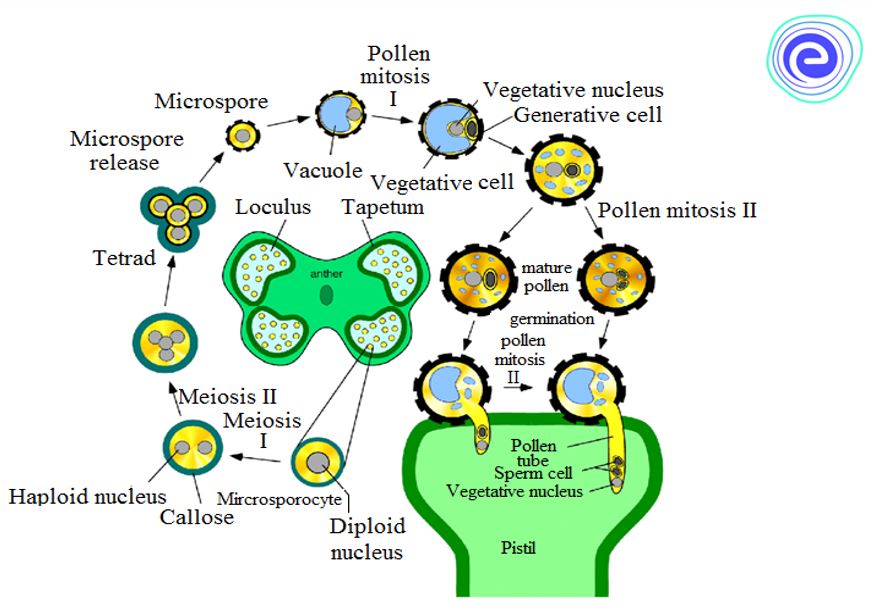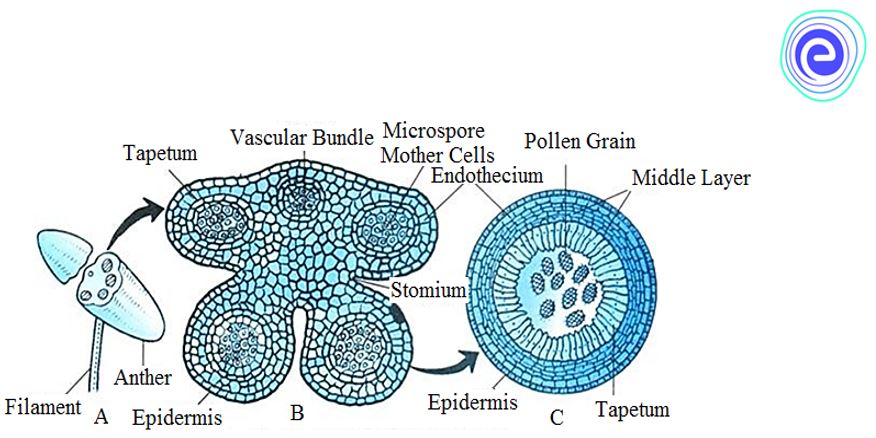Microsporogenesis is the formation of microspores inside pollen sacs of seed plants.
Index
Explanation
The process of microsporogenesis occurs through meiosis or reduction division within the microsporangium or pollen sacs of flowering plants, resulting in the production of microspores or pollen grains.
These microspores represent the initial cell of the male gametophyte that eventually generates male gametes.
To elaborate, microsporogenesis takes place as a consequence of meiosis or reduction division inside the nucleus of each microspore mother cell, leading to the formation of four haploid nuclei.
The process involves the transformation of diploid sporogenous cells into microsporocytes or pollen mother cells (also called meiocytes) that divide and produce four haploid microspores through meiosis.
Upon completion, each diploid meiocyte’s tetrad of four haploid microspores gives rise to individual single-celled haploid microspores.

Structure of Microsporangium
The following points briefly describe the structure of microsporangium:
- Stamen is the male reproductive organ of a flower that has a bilobed anther attached to the filament.
- Each lobe of the anther contains two pollen sacs or microsporangia, which contain thousands of pollen grains.
- The anther in Angiosperms is tetrasporangiate, with the microsporangia appearing to lie at four corners of the anther.
- The two lobes of the anther are joined by a connective that contains the vascular bundle which carries the nutrients.
- Each microsporangium has two parts: the outer wall and central homogenous sporogenous tissue.
- The wall of the microsporangium has four layers: epidermis, endothecium, 1-3 layer thick middle layers, and the innermost tapetum.
- The epidermis, endothecium, and middle layers are protective in function, while the endothecium helps in the splitting of ripe anther to release pollen grains.
- The middle layer degenerates at maturity, and tapetum is the innermost wall layer that nourishes the developing pollen grains.
- Tapetum cells have dense cytoplasm and generally possess more than one nucleus.
- The center of the microsporangium has compactly arranged homogenous cells called sporogenous cells or microsporocytes.
- A microsporocyte has abundant cytoplasm and a prominent nucleus.

FAQ’S
Microsporogenesis refers to the biological process of meiotic or reduction division that occurs within the microsporangium (pollen sacs) of flowering plants, leading to the production of pollen grains or microspores.
Microsporogenesis is a crucial process in the sexual reproduction of plants. It involves the production of pollen grains in the anther, which contain two haploid male gametes. This ensures that the original chromosome number is restored upon fertilization.
Microsporogenesis results in the formation of pollen grains, which subsequently give rise to male gametes.
Microsporogenesis involves the process of meiosis, which results in the formation of a haploid microspore from a diploid microspore mother cell (MMC).
The layer of microsporogenesis refers to the four layers surrounding a typical microsporangium of angiosperms, which include the epidermis, endothecium, 1-3 layer thick middle layers, and tapetum.
Relate Topics
